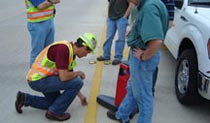Drivers have numerous tools they can use in their quest to drive safely. Properly maintained traffic signs and pavement markings are two of them.
The Federal Highway Administration (FHWA) originally aimed its Manual on Uniform Traffic Control Devices (MUTCD) at ensuring that signs and markings were uniform in their design and placement. This promoted consistent recognition on the driver’s part, which reinforced learning and guided driving behavior. More recently, FHWA expanded the role of the MUTCD to include specific maintenance performance levels.
“Under its original mandate, the MUTCD mentioned maintaining signs and markings for ‘adequate visibility’ but didn’t really define what that was,” explains Paul Carlson, head of TTI‘s Operations and Design Division. “Over the past decade, TTI has been working with FHWA to help create those minimum maintenance performance standards for properly assessing the nighttime visibility of signs and markings.”
Helping Local Agencies Improve Sign Retroreflectivity
Since nighttime crashes occur at nearly three times the rate of daytime crashes, improving visibility at night has become a national priority. To increase their visibility during nighttime conditions, signs are covered by retroreflective sheeting materials. So, how well a sign reflects light — it’s retroreflectivity value — is especially important to traffic safety at night.
“Signs typically have a lifespan of 7 to 15 years. Over time, their retroreflectivity suffers death by natural causes, so to speak,” explains Carlson.
Their number one killer? Ultraviolet light.
As retroreflectivity degrades, the ability of signs and markings to help drivers navigate safely fails as well. So FHWA recently established a sequential set of deadlines by which all agencies must comply with new retroreflectivity standards for warning, regulatory and guide signs. But this could prove challenging for some since sign maintenance usually occurs at the local level — and not every community has a traffic engineer on staff.
Carlson and his team recently partnered with FHWA to determine what maintenance methods were most effective in assessing signs for replacement. Taking the needs of small cities, counties, townships, and Tribal and federal land management agencies into account, Carlson’s team created the Retroreflectivity Toolkit. It’s a step-by-step, how-to guide that empowers agencies to choose a method that best suits them and even helps them create a sample budget as they begin their maintenance planning. The toolkit, containing a guidebook and interactive CD-ROM, should be available this summer.
“The toolkit puts the procedures necessary for meeting the new maintenance standards in the hands of every small agency nationwide,” explains Matt Lupes, highway engineer with FHWA‘s Office of Safety. “Lives will be saved as a result.”
But Carlson and his team haven’t stopped there. They’re currently working on a project to improve the way agencies test how effective road markings are on rainy nights.
(Re)creating the Standard for Testing Wet-Weather Pavement Markings
In 2005, Carlson’s team completed a study for the Texas Department of Transportation (TxDOT) to evaluate the testing of wet-weather pavement markings. More specifically, they evaluated the testing method recommended under ASTM International’s E 2176-01 standard. What they found was disturbing.
“When a standard test method comes out, departments of transportation around the country begin adapting their specifications based on the test method results,” says Carlson. “What we discovered was that the E 2176-01 standard test method for taking retroreflectivity measurements on rainy nights wasn’t valid for the vast majority of pavement marking materials.”
As a result, anyone using that method to test their wet pavement markings at night is likely generating data that don’t accurately reflect true nighttime wet performance. Often markings rated as “bad” using the method are actually fine. If agencies base their decision on these data, they could end up replacing markings before their time, unnecessarily increasing overall maintenance costs.
“Currently, there is no reliable standard test method for conventional pavement markings,” Carlson notes. “It’s extremely important to get a standard in place because it’s not uncommon for reflective materials to work extremely well during dry periods but poorly during rainy conditions.”
On March 24, Carlson invited his fellow ASTM International Technical Committee members to Bryan/College Station to gather data using a new standard test method created by TTI. The method is specifically designed to provide accurate measures of pavement marking performance under continuous wetting conditions. The test results have been documented and were discussed during June’s ASTM International meeting. If all goes as planned, a standard could be in place by the end of the year.
“This is a great example of how the entire nation benefits from excellent research at the state level,” explains Carl Andersen, Roadway Team Leader in the FHWA Office of Safety Research and Development. “While Paul’s TxDOT project was aimed at improving nighttime driving safety for Texans, citizens all across the country — all around the world, in fact — will benefit from the findings.”
When he discusses his work and its global impact in improving safety, Carlson is somewhat philosophical.
“That’s why I do this job. Research is interesting in its own right, but making a difference in people’s lives based on that research — now, that’s what we’re here for.”
This story first appeared in the May 2009 issue of The Road Beacon.

